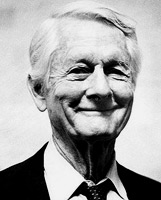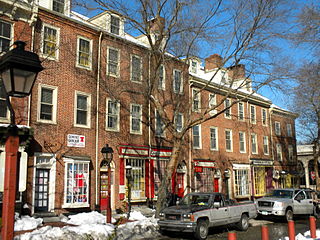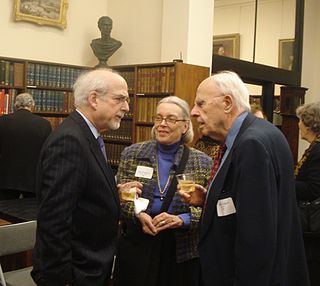Related Research Articles

Frank Owen Gehry is a Canadian-born American architect and designer. A number of his buildings, including his private residence in Santa Monica, California, have become world-renowned attractions.

Washington, D.C., formally the District of Columbia and commonly called Washington or D.C., is the capital city and federal district of the United States. The city is on the Potomac River, across from Virginia, and shares land borders with Maryland to its north and east. Washington, D.C., was named for George Washington, a Founding Father and the first president of the United States. The district is named for Columbia, the female personification of the nation.

Lee Oscar Lawrie was an American architectural sculptor and an important figure in the American sculpture scene preceding World War II. Over his long career of more than 300 commissions Lawrie's style evolved through Modern Gothic, to Beaux-Arts, Classicism, and, finally, into Moderne or Art Deco.

The Philadelphia Museum of Art (PMoA) is an art museum originally chartered in 1876 for the Centennial Exposition in Philadelphia. The main museum building was completed in 1928 on Fairmount, a hill located at the northwest end of the Benjamin Franklin Parkway at Eakins Oval. The museum administers collections containing over 240,000 objects including major holdings of European, American and Asian origin. The various classes of artwork include sculpture, paintings, prints, drawings, photographs, armor, and decorative arts.
The year 2007 in architecture involved some significant architectural events and new buildings.
Adolph Alexander Weinman was a German-born American sculptor and architectural sculptor.

Paul Philippe Cret was a French-born Philadelphian architect and industrial designer. For more than thirty years, he taught at a design studio in the Department of Architecture at the University of Pennsylvania.

Edmund Norwood Bacon was an American urban planner, architect, educator, and author. During his tenure as the executive director of the Philadelphia City Planning Commission from 1949 to 1970, his visions shaped today's Philadelphia, the city of his birth, to the extent that he is sometimes described as "The Father of Modern Philadelphia". He authored the seminal urban planning book Design of Cities.

Society Hill is a historic neighborhood in Center City Philadelphia, Pennsylvania, United States, with a population of 6,215 as of the 2010 United States Census. Settled in the early 1680s, Society Hill is one of the oldest residential neighborhoods in Philadelphia. After urban decay developed between the late 19th and early 20th centuries, an urban renewal program began in the 1950s, restoring the area and its many historic buildings. Society Hill has since become one of the most expensive neighborhoods with the highest average income and second-highest real estate values in Philadelphia. Society Hill's historic colonial architecture, along with planning and restoration efforts, led the American Planning Association to designate it, in 2008, as one of the great American neighborhoods and a good example of sustainable urban living.

The San Francisco Federal Building, formally the Speaker Nancy Pelosi Federal Building, is an 18-story, 234 ft-tall (71.3 m) building at 90 7th Street on the corner of Mission and 7th streets in the South of Market neighborhood of San Francisco, California. The federal building was designed by the Morphosis architectural firm, as a supplement to the Phillip Burton Federal Building several blocks away. Thom Mayne of Morphosis designed the building using a juxtaposition of gray concrete walls, perforated metal panels, and custom, faceted wood ceilings. The building was expected to be completed in 2005, but construction issues and delays pushed the project completion to 2007.

The Dwight D. Eisenhower Memorial is a United States presidential memorial in Washington, D.C. honoring Dwight David Eisenhower, the Supreme Commander of the Allied Forces in Europe during World War II and the 34th President of the United States.

Downtown is the central business district of Washington, D.C., located in Northwest D.C. It is the third largest central business district in the United States. The "Traditional Downtown" has been defined as an area roughly between Union Station in the east and 16th Street NW in the west, and between the National Mall on the south and Massachusetts Avenue on the north, including Penn Quarter. However, nowadays, Downtown D.C. usually refers to a larger area, as the DC Office of Planning states:
…most residents, workers, and visitors think of Downtown in a broader sense — including areas as far north as Dupont Circle, as far west as Foggy Bottom, and as far east as Capitol Hill. Only about half of the central city workforce is located within the city’s traditional Downtown.

Bruce Milan Cole was a longtime professor of art history at Indiana University, a Senior Fellow at the Ethics and Public Policy Center in Washington, D.C., a member of the Eisenhower Memorial Commission, and the eighth Chair of the National Endowment for the Humanities.

The U.S. Commission of Fine Arts (CFA) is an independent agency of the federal government of the United States, and was established in 1910. The CFA has review authority over the "design and aesthetics" of all construction within Washington, D.C. In accordance with the Old Georgetown Act, the CFA appoints the Old Georgetown Board. The Old Georgetown Board has design review authority over all semipublic and private structures within the boundaries of the Georgetown Historic District. The CFA was granted approval authority by the Shipstead-Luce Act over the design and height of public and private buildings which front or abut the grounds of the United States Capitol, the grounds of the White House, Pennsylvania Avenue NW extending from the Capitol to the White House, Lafayette Square, Rock Creek Park, the National Zoological Park, the Rock Creek and Potomac Parkway, Potomac Park, and the National Mall and its constituent parks.

Federal modernism is an architectural style which emerged in the twentieth century encompassing various styles of modern architecture used in the design of federal buildings in the United States. Federal buildings in this style shunned ornamentation, focusing instead on functional efficiency and low costs. There is no universally accepted start date for federal modernism, with some early variants of modernism emerging as early as the 1920s, but the term is most often associated with the buildings built by the U.S. General Services Administration (GSA) in the 1950s through 1970s. Prominent architects associated with federal modernism include Ludwig Mies van der Rohe, Marcel Breuer, Walter Gropius, and Victor Lundy. Federal modernism has been criticized by some architects and politicians such as Donald Trump, either because they believe it lacks "authority" or due to a perceived lack of beauty.

The Perelman Performing Arts Center, branded as PAC NYC, is a multi-space performing arts center at the northeast corner of the World Trade Center complex in Manhattan, New York City. The Performing Arts Center is located at the intersection of Vesey, Fulton, and Greenwich Streets in Lower Manhattan. The building is named for billionaire Ronald Perelman, who donated $75 million to its construction.
The year 2021 in architecture involved some significant architectural events and new buildings.

A National Garden of American Heroes was proposed by President Donald Trump in executive orders on July 3, 2020, and January 18, 2021, as a sculpture garden honoring "great figures of America's history". Trump first announced the idea at an Independence Day event at Mount Rushmore in Keystone, South Dakota. The sculpture garden idea was part of a series of executive orders issued by Trump in his final months in office to address conservative cultural grievances; the second of the two executive orders was issued two days before Trump's term expired. Congress never appropriated funding for such a garden, nor were concrete steps ever taken to construct such a site. President Joe Biden revoked the executive orders relating to the garden in May 2021.
Justin Shubow is an American architectural critic who currently serves as the president of the National Civic Art Society, a nonprofit organization that advocates and promotes public art and architecture in the classical tradition. He was a member of the United States Commission of Fine Arts from 2018 to 2021 and served as its chairman in 2021, being the first Jew to hold that position.

Washington, D.C., the capital of the United States, has a unique and diverse architectural history. Encompassing government, monumental, commercial, and residential buildings, D.C. is home to some of the country's most famous and popular structures designed by some of the leading architects of their time. The popularity of the city's buildings is reflected in the findings of a 2007 poll of Americans by the American Institute of Architects, which found that six of the top 10 most popular U.S. structures were located in Washington, D.C. Overall, the poll found, 17 of the top 150 most popular structures were located in the capital.
References
- ↑ Capps, Kriston (October 14, 2020). "Classical or Modern Architecture? For Americans, It's No Contest". Bloomberg Citylab. Retrieved November 15, 2020.
- ↑ Rogers, Katie; Pogrebin, Robin (February 5, 2020). "Draft Executive Order Would Give Trump a New Target: Modern Design". The New York Times . Retrieved November 15, 2020.
- ↑ Kimmelman, Michael (February 7, 2020). "MAGA War on Architectural Diversity Weaponizes Greek Columns". The New York Times. Retrieved November 15, 2020.
- ↑ Gutschow, Kai (February 16, 2020). "Why so many architects are angered by "Making Federal Buildings Beautiful Again"". Salon . Retrieved November 15, 2020.
- ↑ Blair, Elizabeth (February 13, 2020). "'Just Plain Ugly': Proposed Executive Order Takes Aim At Modern Architecture". National Public Radio . Retrieved November 15, 2020.
- ↑ Berger, Paul (November 23, 2017). "Campaigners Step Up Fight to Restore New York Penn Station". Wall Street Journal. Retrieved November 15, 2020.
- ↑ "National World War I Memorial". National Civic Art Society. Retrieved February 25, 2021.
- ↑ "Rebuilding New York's Original Penn Station". National Civic Art Society. Retrieved February 25, 2021.
- ↑ "National Eisenhower Memorial". National Civic Art Society. Retrieved February 25, 2021.
- ↑ Blair, Elizabeth (February 13, 2020). "'Just Plain Ugly': Proposed Executive Order Takes Aim At Modern Architecture". National Public Radio . Retrieved November 15, 2020.
- ↑ "Americans' Preferred Architecture for Federal Buildings". National Civic Art Society.
- ↑ Capps, Kriston (October 14, 2020). "Classical or Modern Architecture? For Americans, It's No Contest". Bloomberg Citylab. Retrieved November 15, 2020.
- ↑ Rogers, Katie; Pogrebin, Robin (February 5, 2020). "Draft Executive Order Would Give Trump a New Target: Modern Design". The New York Times. ISSN 0362-4331 . Retrieved June 23, 2021.
- ↑ "Promoting Beautiful Federal Civic Architecture". Federal Register. December 23, 2020. Retrieved June 23, 2021.
- ↑ "Trump signs executive order mandating classical architecture for D.C. federal buildings". The Architect’s Newspaper. December 21, 2020. Retrieved June 23, 2021.
- ↑ "Frank Gehry's Eisenhower Memorial Opens in Washington, D.C." www.architecturalrecord.com. Retrieved June 23, 2021.